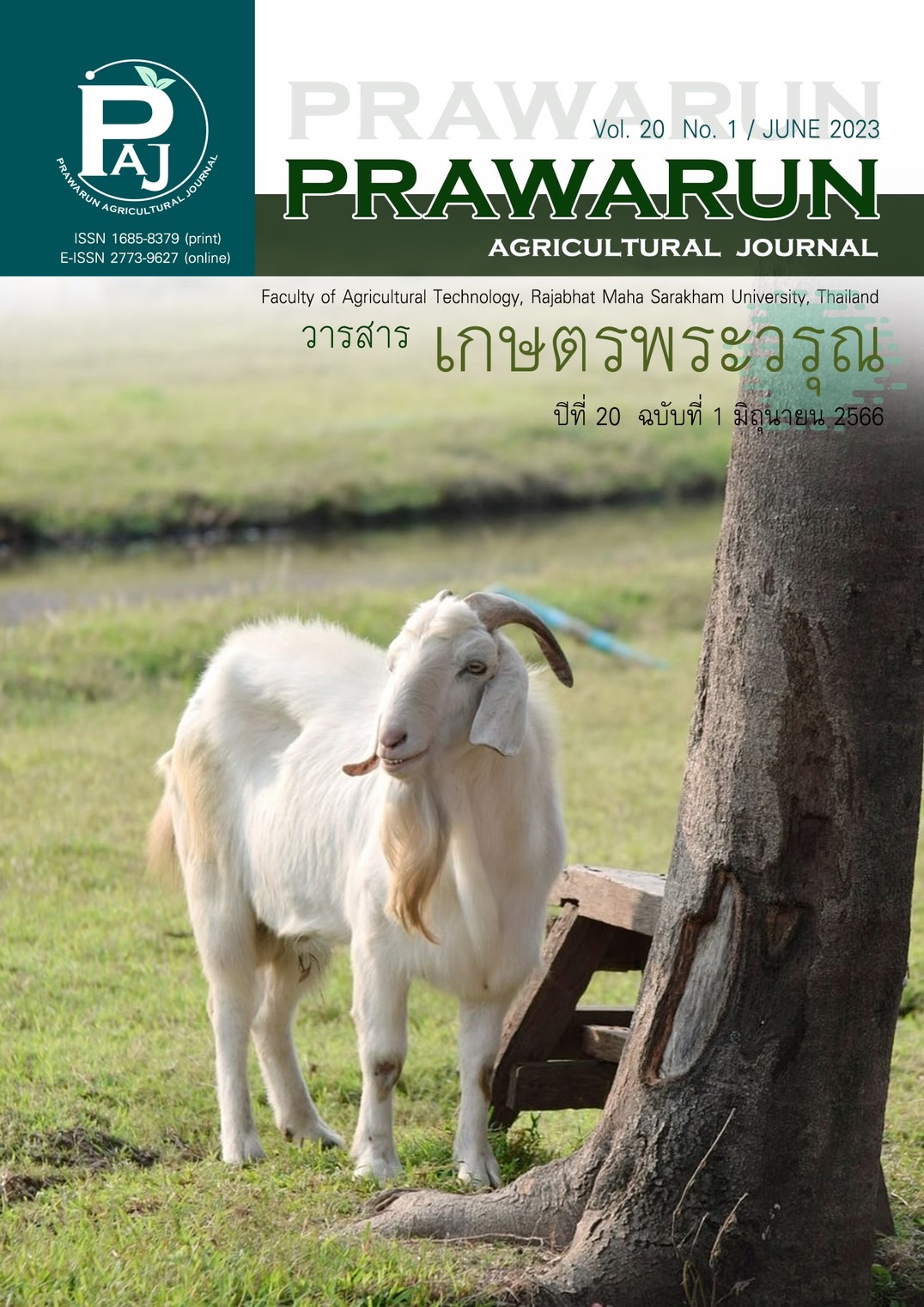การพัฒนาผลิตภัณฑ์ขนมขบเคี้ยวชนิดพองกรอบที่ผลิตจากแป้งข้าวกล้องสังข์หยดพัทลุง ด้วยกระบวนการเอกซ์ทรูชันเสริมอินูลิน
Main Article Content
บทคัดย่อ
งานวิจัยนี้วิเคราะห์คุณภาพทางเคมีและกายภาพจากข้าวกล้องสังข์หยดพัทลุงและพัฒนาผลิตภัณฑ์ขนมขบเคี้ยวชนิดพองกรอบเสริมอินูลินที่ผลิตจากแป้งข้าวกล้องสังข์หยดพัทลุงด้วยกระบวนการเอกซ์ทรูชัน พบว่าข้าวกล้องสังข์หยดพัทลุง มีค่า Water activity (aw) เท่ากับ 0.56 ค่าสี L*, a* และ b* เท่ากับ 61.75, 8.16 และ 13.06 ตามลำดับ องค์ประกอบทางเคมีประกอบด้วยความชื้น ไขมัน ใยอาหาร เถ้า โปรตีนและคาร์โบไฮเดรตร้อยละ 9.45, 2.58, 3.87, 1.25, 8.28 และ 74.57 ตามลำดับ สารประกอบฟีนอลิกทั้งหมด และฤทธิ์ต้านอนุมูลอิสระ DPPH เท่ากับ 102.41 mg GAE/100 g sample และ 921.32 mg TE/100 g sample ตามลำดับ ผลจากการเพิ่มปริมาณอินูลินร้อยละ 5, 10 และ 15 ส่งผลให้เส้นใยอาหารเพิ่มขึ้น ค่าความหนาแน่นและค่าความแข็งลดลงแต่อัตราการพองตัวและค่า L* เพิ่มขึ้นตามการเพิ่มขึ้นของปริมาณอินูลิน จากการผลิตขนมขบเคี้ยวด้วยกระบวนการเอกซ์ทรูชัน การเพิ่มปริมาณอินูลินส่งผลต่อค่า a* และ b* ไม่มีความแตกต่างกันทางสถิติ (p>0.05) การทดสอบทางประสาทสัมผัส พบว่า ผู้บริโภคให้คะแนนความชอบด้านสี และกลิ่น ไม่แตกต่างกันทางสถิติ (p>0.05) ในขณะที่คะแนนความชอบด้านความกรอบ รสชาติ และความชอบโดยรวมมีความแตกต่างอย่างมีนัยสำคัญทางสถิติ (p<0.05) โดยอินูลินร้อยละ 10 ได้คะแนนความชอบด้านความกรอบ รสชาติ และความชอบโดยรวมสูงสุด คุณค่าทางโภชนาการของขนมขบเคี้ยวชนิดพองกรอบที่ผลิตจากแป้งข้าวกล้องสังข์หยดพัทลุงด้วยกระบวนการเอกซ์ทรูชัน พบว่า ผลิตภัณฑ์มีพลังงานทั้งหมด 110 กิโลแคลอรี พลังงานจากไขมัน 10 กิโลแคลอรี ไขมันทั้งหมด 1 กรัม โปรตีน 2 กรัม คาร์โบไฮเดรตทั้งหมด 24 กรัม แคลเซียม 2.17 มิลลิกรัม ต่อหนึ่งหน่วยบริโภค
Article Details
เอกสารอ้างอิง
American Association of Cereal Chemists (AACC). (2010). AACC Approved methods of analysis (11th ed.). Minnesota: American Association of Cereal Chemists International.
Association of Official Analytical Chemists (AOAC). (2000). Official methods of analysis of AOAC international (17th ed.). Maryland: Association of Official Analytical Chemists.
Banchuen, J., Thammarutwasik, P., Ooraikul, B. Wuttijumnong, P., & Sirivongpaisal. P. (2009). Effect of germinating processes on bioactive component of Sangyod Muang Phatthalung rice. Thai Journal of Agricultural Science, 42(4), 191-199.
Central Laboratory. (2022). Test results for puffed snack (Research report). Hat Yai,: Songkhla.
Chalermchaiwat, P., Jangchud, K., Jangchud, A., Charunuch, C., & Priyawiwatkul, W. (2015). Antioxidant activity, free gamma-aminobutyric acid content, selected physical properties and consumer acceptance of germinated brown rice extrudates as affected by extrusion process. LWT - Food Science and Technology, 64(1), 490-496.
Chanlat, P., Songsermpong, S., Charunuch, C., & Naivikul, O. (2011). Twin-screw extrusion of pre-germinated brown rice: Physicochemical properties and γ-aminobutyric acid content (GABA) of extruded snacks. International Journal of Food Engineering, 7(4), 1-15. doi:10.2202/1556-3758.2328
Charoenkul., A. (2010). Introduction to food processing. Bangkok: University of the Thai Chamber of Commerce.
Dehghan-Shoar, Z., Hardacre, A. K., & Brennan, C. S. (2010). The physico-chemical characteristics of extruded snacks enriched with tomato lycopene. Food Chemistry, 123(4), 1117-1122.
Devi, N. L., Shobha, S., Tang, X., Shaur, S. A., Dogan, H., & Alavi, S. (2013). Development of protein-rich sorghum-based expanded snacks using extrusion technology. International Journal of Food Properties, 16(2), 263-276.
Ding, Q. B., Ainsworth, P., Tucker, G., & Marson, H. (2005). The effect of extrusion conditions on the physicochemical properties and sensory characteristics of rice-expanded snacks. Journal of Food Engineering, 66(3), 283–289.
Eurominitor International. (2022). Savoury snacks in Thailand. Accessed January 30, 2023. Retrieved from https://www.euromonitor.com/savoury-snacks-in-thailand/report
Kaewjun, D. (2015). Supplementation of prebiotic dietary fibers in rice cracker (Master’s thesis). Nakhon Pathom: Silpakorn University. (in Thai)
Moongngarm, A. (2012). Antioxidants in cereal grains. Maha Sarakham: Mahasarakham University Press.(in Thai)
Office of the Health Promotion Fund. (2018). Chronic non-communicable disease group. Accessed December 6, 2023. Retrieved from http://www.thaihealth.or.th/microsite/categories/5/ncds/2/173/176-NCDs.html (in Thai)
Peressini, D., Foschia, M., Tubaro, F., & Sensidoni, A. (2015). Impact of soluble dietary fibre on the characteristics of extruded snacks. Food Hydrocolloids, 43(2), 73-81. doi: 10.1016/j.foodhyd.2014.04.036
Phondongnok, S., Rattanachaiwong, S., Wichai, C., & Thonrat, T. (2015). Knowledge of belly obesity = metabolic syndrome. Khon Kaen: Klang Nana Wittaya Printing Press. (in Thai)
Rattanapanone, N. (2008). Food Chemistry (3rd ed.). Bangkok: O.S. Printing House. (in Thai)
Rattanasakornchai, S. (2018). Factors affecting food consumption behavior of Mathayom Suksa 3 students in Mueang Chumphon District, Chumphon Province. Thai Food and Drug Journal, 22(1), 61-72. (in Thai)
Samaisong, N. (2020). Dietary management for prevention and reduction risk of non-communicable diseases. Songklanagarind Journal of Nursing, 40(4), 122-130. (in Thai)
Waratornpaibul, T. (2014). Consumption behavior: Consumerism food and healthy-conscious food. Panyapiwat Journal, 5(2), 255-264. (in Thai)
Xu, E., Pan, X., Wu, Z., Long, J., Li, J., Xu, X., Jin, Z., & Jia, A. (2016). Response surface methodology for evaluation and optimization of process parameter and antioxidant capacity of rice flour modified by enzymatic extrusion. Food Chemistry, 212(1), 146-154.


